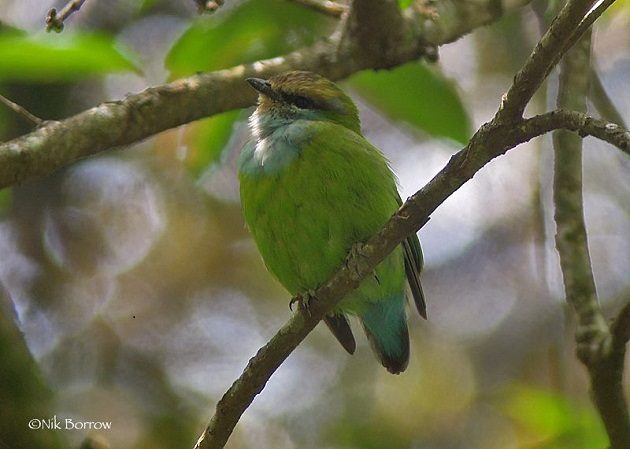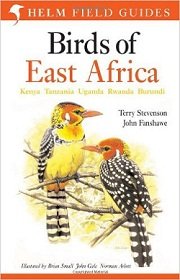
It’s hot outside and inside… I am drinking the WHE brew, a Belgrade beer made upon a Neolithic Turdas-Vinca culture recipe (a great brew, my only complaint: bottles are girly-small!) and dreaming of a place where the heat is moderate, beer snake-cold and birds innumerable…
Let’s say, where the average annual maximum varies from 22 to 24 degrees Celsius / 72 to 75 Fahrenheit and where some 700+ bird species – 24 of them endemic – are waiting for an intrepid birder… Answer to the riddle? Directly under the Equator: southwestern Uganda!
While the country as a whole has almost 1100 species (it is possible to nail up to 665 of them in three weeks), the area to focus on is the southwest (like in the US). What is 665 birds? I am 50 years old and 665 is ten species longer than my life listl! (Phoebe Snetsinger had that experience while birding East Africa for the first time and seeing as many birds as she did in the US for the previous 50 years.)

Queen Elizabeth National Park has more than 600 species of birds, while the Bwindi Impenetrable Forest has more than 400. Also, Bwindi with all 24 Albertine Rift endemics found in Uganda and Mgahinga NP with 13 of them are the most accessible sites for endemics such as Handsome Francolin, Rwenzori Turaco, Rwenzori Batis, Dusky and Shelley’s Crimsonwings, and the highly localised African Green Broadbill (above – photo by Nik Borrow). In “Where to Watch Birds in Africa”, Nigel Wheatley says: “In terms of its size, Uganda is the richest country for birds in Africa.”
Add to this picture local cultures of Batwa, Bakiga and Bafumbira ethnic groups; then mammals like Mountain Gorillas (recent DNA tests indicate that Bwindi and Mgahinga population may consist of two different Mountain Gorilla subspecies – both Critically Endangered), Chimpanzees and Golden Monkeys, both Forest and Savanna Elephants, both Red and Savanna Buffalos, etc.; also the crime rate lower than in developed countries, stable politics, reasonable prices and landscapes as green as can be.
 Bird book of choice is the “Birds of East Africa” by Terry Stevenson and John Fanshawe, a Helm Field Guide covering Kenya, Tanzania, Uganda, Rwanda and Burundi – also the first complete guide to cover the 1388 species found in this region. Try to lay your fingers on a copy of “Where to watch birds in Uganda” by Jonathan Rossouw and Marco Sacchi (this one I still miss). A travel guide for birders should be the “Bradt Guide to Uganda” written by Philip Briggs, who is a birder himself!
Bird book of choice is the “Birds of East Africa” by Terry Stevenson and John Fanshawe, a Helm Field Guide covering Kenya, Tanzania, Uganda, Rwanda and Burundi – also the first complete guide to cover the 1388 species found in this region. Try to lay your fingers on a copy of “Where to watch birds in Uganda” by Jonathan Rossouw and Marco Sacchi (this one I still miss). A travel guide for birders should be the “Bradt Guide to Uganda” written by Philip Briggs, who is a birder himself!
Also, find some practical and down to earth travel advices for the Mountain “Gorilla Highlands” region (southern Uganda and northern Rwanda) in this pdf brochure (40 Mb).
I sure hope to get there. And would love to meet you there. In case you find this blog a bit short, don’t blame me: my tiny bottle of WHE is already empty.
Cover photo: volcanoes in the Mgahinga Gorilla National park seen from the Mutanda Lake. Photo by Marcus Westberg / Gorilla Highlands











WOW!! That just has to go on the “Bucket List”…and I have a nick name for those tiny bottles, Training Beers!
Tom
I lived there for 6 months and the first afternoon in a backpackers in Kampala set the scene: Palm-nut Vulture, Ross’s Turaco and Broad-billed Roller amongst others. I think my favourite was a Black Bee-eater in a tree over my home in Kibale – it was there for three days when I first arrived and I assumed it was common enough, then didn’t see another for the rest of the trip.
Also I remember my guide at Bwindi telling me that an Oriole Finch was a once every six months bird for him, then getting progressively more embarrassed as we saw three more!
I spent February this year assessing the environs of Bwindi Impenetrable Forest as a birding tourism destination. Access to the National Park is very limited (expensive) but you can enjoy good birding along its edges and nearby. Temperature was higher than suggested – I think we maybe got to 30 deg C. midday.
I wrote about my experiences on my site here: http://www.mybirdoftheday.ca/birding-in-uganda/
Sounds incredible.
I couldn’t believe there really were 0.7 pints, appeared much smaller
And Uganda is as safe as Botswana, but has the full range of accommodation options, not just the upper end
What a bird cocktail!
I’d go nut over a Palm-nut!
Bravo for such an interesting work and an exciting blog!
The temperatures are for Kibale and are the average maximums (sort of mid-maximum temperatures, not an absolute maximum).
African Bird Club still quotes the number of bird species in Bwindi as 350, but Buhoma eBird hotspot in Bwindi has 413 and there are half a dozen more hotspots in the park.
BTW, if you have any particular advice for a birding beginner in Uganda, what would it be?
I would say the best thing you can do is get a local guide. There are many Ugandans interested in birds and nature.
I stayed in Rubugari, a very small village close to the Bwindi NP. In that village they have an enthusiastic birding club called the Bwindi South Bird Guides Club. (I am actually their Patron, – they asked me.)
Suggest you contact Baturine Emma through facebook. He is a very good birder , he found lots of cool birds for me and knew many species by call.
Alternatively go online to Big Beyond it is a small British aid agency that does work with the community to advance their development. You may find leads to something good.
Better though if you email me for more. (Next week I’m going away for 2 weeks.)
Uganda is truly a great country for birding, but no one sees over 600 species in three weeks. Keep sipping those training brews!
http://birdinguganda.blogspot.ug/
This web page [ http://www.kikooko.travel/en/Birding-Safaris.htm ] claims: “The record for the number of species recorded in a three-week period is 665!”
Perhaps they are not trustworthy?